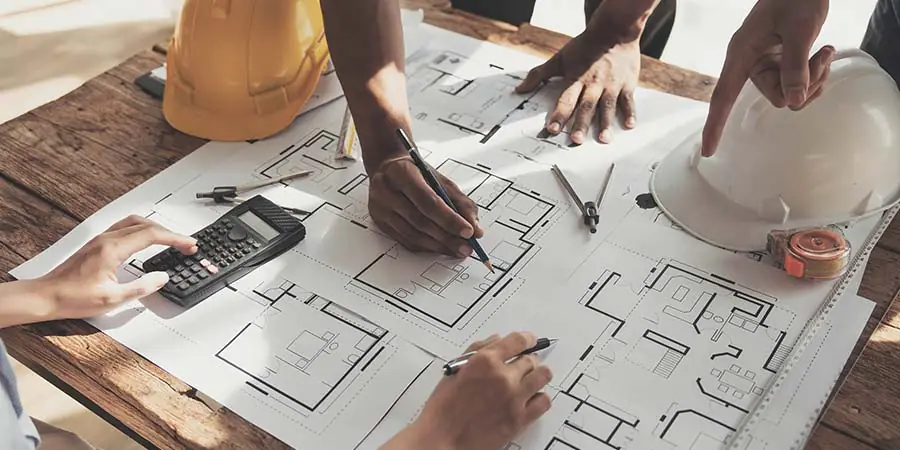
The architectural design was striking. Spacious areas, tidy and defined lines, along with a purposeful interaction of light and shape. The engineering team had also done its part, developing a mechanical layout that ticked all the boxes for energy performance and airflow. However, during model coordination, it became apparent that the ceiling height would not accommodate both the lighting fixtures and ductwork. The options? Redesign one or both systems. Weeks of effort now had to be reworked.
It is a typical incident that most project teams have encountered at least once. Despite everyone doing their job well, minor disconnects—especially early in the process—can snowball into costly, time-consuming problems later. In AEC, it is rarely a question of competence. More often, it is a gap in coordination.
At Uppteam, we have worked alongside firms where this kind of misalignment was once routine. The difference occurs when collaboration becomes an integral part of the design workflow rather than something added on afterward.
What Breaks Down in Architect–Engineer Collaboration
If design coordination fails, it rarely occurs in a single dramatic moment. Instead, it breaks down in subtle ways:
Teams work in silos—often by default
Architects move fast in the early design phases. Engineers typically come in later. By the time structural or MEP input arrives, major spatial decisions are already locked in. No one is at fault. The timelines just didn’t match.
Early input is skipped or delayed.
Sometimes, engineers are not looped into conversations about layouts or core positioning until the design development (DD) phase. That leaves little room to rethink duct placement or access clearances without triggering redesigns.
Documentation is not passed on clearly.
Between schematic and detailed design, many changes occur. But unless someone is tracking decisions and updating shared references, things get missed. The ceiling plans remain unchanged, while the lighting specification is updated. Equipment gets relocated, but no one revises the riser diagram.
Software platforms do not play nice.
One team models in Revit and another prefers ArchiCAD or SketchUp. Even within Revit, families, levels, and naming conventions vary. Merging models becomes manual work. Coordination turns into cleanup.
These are not theoretical issues. They are recurring points of conflict that delay progress and frustrate both design and construction teams.
The Real Cost of Poor Collaboration
When coordination falters, the effects ripple across the project. Industry research indicates that coordination issues are responsible for approximately 30% of construction delays, with poor interdisciplinary communication being a primary contributor.
Rework eats up valuable time. Fixing issues in documentation is less expensive than in construction, but it is still a costly endeavor. Studies indicate that addressing coordination conflicts during design development costs roughly 10 times less than resolving them during construction.
RFIs flood in. Ambiguous layouts or inconsistent specifications trigger dozens of clarification requests, each adding to the delay. Projects with poor coordination typically generate 40-60% more Requests for Information (RFIs) than well-coordinated ones.
Site teams lose confidence in the drawings. When discrepancies continue to surface, they stop trusting the design. This leads to defensive construction practices and additional contingencies that inflate costs.
Clients notice. Timeline slips, scope creep, and budget overruns reflect poorly on everyone, regardless of who is responsible.
Behind every coordination miss lies a cost that is measured not just in money, but also in trust.
What Helps Prevent These Problems
Some firms rely on experience and good instincts to keep everyone aligned. That works—until it does not. More reliable are the habits and tools that build collaboration into the workflow.
Involve engineers earlier
Many spatial clashes can be avoided if MEP or structural input is factored in from the beginning. A ceiling that is two inches higher or a riser shifted a meter to the right might save six weeks of rework down the line. Consider the following example: During a recent office renovation, early structural analysis revealed that the existing slab could not support the planned mechanical units without reinforcement. By identifying this issue during schematic design rather than in the construction documents (CD), the team saved three weeks and $50,000 in structural modifications.
Use shared models and common standards.
Even if teams use different platforms, agreed-upon modeling conventions—such as layer names, file structures, and element IDs—facilitate collaboration. When everyone knows what to expect in a shared model, handovers do not become translation exercises.
Align drawings with buildable reality.
Designs should not only meet the brief—they should leave room for systems to run cleanly. Effective space planning takes into account factors such as ductwork turns, fixture spacing, and maintenance access.
Do not leave communication to email
A short weekly sync or a shared audit log can catch a lot early. Even 15 minutes reviewing model overlays together can surface conflicts that a dozen emails might miss.
These are not groundbreaking ideas. But they are often the difference between a project that runs smoothly and one that constantly feels like reactive problem-solving.
Where Uppteam Fits In
Uppteam works behind the scenes to help project teams avoid these traps. Our focus is on design-phase support that keeps architectural, structural, and MEP disciplines in sync from the start.
We handle the coordination layer, managing building model renditions, clash information, and documentation across disciplines.
We flag issues before they reach the site, catching spatial overlaps, missing clearances, or spec inconsistencies early.
We help maintain continuity, ensuring that what is approved in DD is carried through cleanly into CD and Industry Foundation Classes (IFC) files for construction.
In one recent project, a commercial fit-out in a high-rise tower, our team identified a misalignment between the lighting layout and chilled water pipe routing. It would have caused delays during ceiling closure. Catching it early prevented rework and avoided a potential six-week hold-up for the general contractor.
In another case, a mixed-use development encountered a coordination challenge due to structural framing conflicts with the proposed HVAC distribution. By running clash detection during the early design development phase, we identified the conflict and worked with both teams to adjust the structural bay spacing by 18 inches. This minor adjustment eliminated the need for costly rerouting of ductwork and maintained the architectural intent.
Design Is a Team Sport
Collaboration in AEC is not just a checkbox—it is a foundation. When architects and engineers collaborate in real-time rather than in sequence, projects stay on track. The handoffs get smoother. The drawings get cleaner. And most importantly, the built result reflects the original vision without compromise or delay.
Misalignment will always cost more than coordination. Fortunately, better design support—upfront, structured, and continuous—can make all the difference.

















